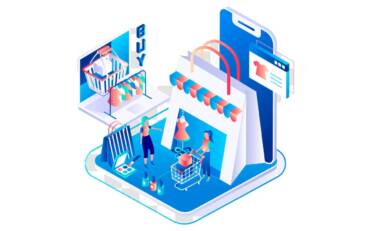In today’s hyper-connected world, e-commerce has become an integral part of our lives. But have you heard of connective ecommerce? Ever wondered what is connective Ecommerce? This emerging trend is revolutionizing the way businesses interact with their customers online.
In this article, we will explore the world of connective e-commerce, its advantages, disadvantages, and everything you need to know to decide if it’s the right strategy for your business. So, let’s dive in and discover the power of connective ecommerce in today’s competitive digital landscape.

Understanding What is Connective eCommerce
Connective ecommerce is like the tech-savvy buddy of online retail. It’s not just about buying and selling—it’s about creating a smooth, personalized journey for both shoppers and businesses.
In connective ecommerce, the focus goes beyond the basics. Additionally, it’s all about weaving together different elements like technology, data, and customer interactions. Think of it as a web of connections that makes the online shopping experience more than just a transaction.
Now, let’s talk tech. With nifty tools like artificial intelligence and data analytics, businesses can get the lowdown on customer behavior and preferences. This means you get personalized product recommendations and spot-on marketing tailored just for you. It’s like having your virtual shopping assistant!
But wait, there’s more! Connective ecommerce is all about being everywhere you are. Furthermore, it’s about making the journey seamless whether you’re on a website, mobile app, or even strolling through a physical store. No bumps in the road, just a smooth ride from start to finish.
So, in a nutshell, connective ecommerce isn’t just about selling stuff online. It’s about creating connections, using cool tech, and making your online shopping experience as personalized and smooth as can be.
Benefits and Drawbacks of connective ecommerce
Benefits of Connective Ecommerce:
Connective ecommerce comes with a bunch of perks that can make the whole online shopping experience a game-changer.
Personalized Shopping Experience: Connective ecommerce is like having a personal shopper at your fingertips. Businesses can use data and AI to understand your preferences, offering tailored product recommendations and a more enjoyable shopping journey.
Omnichannel Consistency: No matter where you shop—website, app, or physical store—connective ecommerce ensures a consistent experience. It’s like a smooth dance where you can switch between channels without missing a beat.
Enhanced Customer Engagement: With a better understanding of customer behavior, businesses can engage shoppers more effectively. This can lead to improved customer loyalty and satisfaction.
Real-time Decision Making: Thanks to data analytics, businesses can make informed decisions on the fly. This agility is a significant advantage in the fast-paced world of ecommerce.
Drawbacks of Connective Ecommerce:
Data Privacy Concerns: The more personalized the experience, the more data is involved. This raises concerns about privacy and how businesses handle and secure sensitive customer information.
Complex Implementation: Achieving a seamless connective ecommerce experience requires a robust technological infrastructure. For some businesses, the complexity of implementation can be a hurdle.
Overreliance on Technology: While technology is a boon, an overreliance on it might lead to a lack of human touch. Balancing technology with personalized human interactions can be a challenge.
Cost of Implementation: Building and maintaining the necessary tech stack for connective ecommerce comes at a cost. Smaller businesses might find it challenging to invest in these advanced technologies.
In the end, connective ecommerce offers a sophisticated and personalized shopping experience, but it’s not without its challenges. As with any advancement, finding the right balance is key to maximizing the benefits while minimizing the drawbacks.
Examples of connective ecommerce platforms
let’s explore some examples of connective ecommerce platforms that are shaking up the online shopping game.
Shopify:
What makes it connective: Shopify is all about making the online shopping experience seamless. It provides a unified platform where businesses can manage their online store, track customer data, and integrate with various channels like social media.

Magento:
What makes it connective: Magento, an Adobe company, offers an open-source e-commerce platform with a focus on flexibility and scalability. It allows businesses to create personalized customer experiences and integrate with third-party tools to enhance connectivity.
Salesforce Commerce Cloud:
What makes it connective: Salesforce Commerce Cloud goes beyond just selling products. It integrates with the broader Salesforce ecosystem, allowing businesses to connect customer relationship management (CRM) with eCommerce for a holistic view of customer interactions.
BigCommerce:
What makes it connective: BigCommerce is known for its flexibility and ease of use. It integrates with various apps and tools, providing businesses with the ability to create a connected e-commerce environment tailored to their specific needs.
WooCommerce:
What makes it connective: As a WordPress plugin, WooCommerce is known for its simplicity and customization. It allows businesses to seamlessly integrate their online store with their WordPress website, providing a cohesive online presence.
SAP Commerce Cloud:
What makes it connective: SAP Commerce Cloud is an enterprise-level solution that integrates with SAP’s broader suite of business applications. This connectivity enables businesses to streamline their operations and deliver personalized experiences to customers.
These platforms showcase the diverse ways in which businesses can embrace connective eCommerce, from small businesses looking for simplicity to enterprises seeking a comprehensive solution that integrates with their broader business processes. Each of these platforms contributes to creating a more connected and personalized online shopping experience.

Strategies for implementing connective e-commerce
Let’s dive into strategies for implementing connective eCommerce, breaking it down step by step with some nifty transition words.
Firstly, Establish Clear Objectives: Before diving into the tech, outline your goals. Identify what you want to achieve with connective e-commerce—whether it’s enhancing customer engagement, improving personalization, or expanding your online presence.
Additionally, Invest in Robust Technology: Select a tech stack that aligns with your objectives. Invest in platforms and tools that support seamless integration, data analytics, and AI capabilities. This lays the foundation for a connective e-commerce ecosystem.
Moreover, Prioritize Data Security and Privacy: With personalized experiences comes the responsibility of handling customer data. Make sure your information is safe by setting up strong security measures. Address privacy concerns by being transparent about data usage and obtaining user consent.
Furthermore, Embrace Omnichannel Consistency: Connective ecommerce thrives on consistency. Ensure a uniform experience across all touchpoints—website, mobile app, social media, and physical stores. This interconnected approach keeps the customer journey smooth and enjoyable.
Moreover, Leverage Customer Feedback and Data: Listen to your customers. Use feedback and data analytics to understand their preferences. This insight is gold—it helps fine-tune your strategy, making the shopping experience even more tailored and enjoyable.
Additionally, Train Your Team: Equip your team with the necessary skills to navigate the connected landscape. Training ensures everyone is on the same page, from understanding the technology to delivering exceptional customer service in the digital realm.
Lastly, Iterate and Adapt: Connective eCommerce is dynamic. Regularly assess your strategy, analyze performance metrics, and be ready to adapt. Embrace a culture of continuous improvement to stay ahead in the ever-evolving e-commerce landscape.
Best practices for successful connective e-commerce
Now, let’s delve into some best practices for successful connective ecommerce, weaving through these strategies seamlessly.
First and foremost, Know Your Audience: Understanding your audience is like having the map to connective success. Learn about your customers by doing research and collecting information to create profiles that represent your typical buyers.
Additionally, Prioritize User Experience (UX): Connective ecommerce thrives on a user-friendly environment. Ensure your website or app is intuitive, easy to navigate, and visually appealing. A positive UX enhances customer satisfaction and encourages repeat visits.
Moreover, Embrace Cross-Channel Consistency: Consistency is key. Whether customers are browsing your website, engaging on social media, or visiting a physical store, maintain a cohesive brand experience. This builds trust and strengthens the connection between your brand and the customer.
Furthermore, Leverage Personalization Wisely: Personalization is the magic wand of connective ecommerce, but use it wisely. Tailor product recommendations, content, and marketing messages based on customer preferences. Strive for a balance that adds value without overwhelming the user.
Optimize for Mobile: In our mobile-centric world, ensure your connective ecommerce strategy is mobile-friendly. Optimize your website and app for various devices to cater to the growing number of mobile shoppers.
Furthermore, Prioritize Customer Support: In the connected world, customer support is a cornerstone. Provide multiple channels for customer inquiries, offer prompt responses, and ensure a positive post-purchase experience. Exceptional customer service strengthens the bond between your brand and customers.
Lastly, Stay Agile and Adaptive: Connective ecommerce is a journey, not a destination. Stay agile and adaptive to evolving technologies, market trends, and customer preferences. Regularly assess and adjust your strategy to stay ahead in the competitive ecommerce landscape.
Limitations and challenges of connective e-commerce
Let’s explore the limitations and challenges of connective eCommerce, adding some transition words for a smooth flow.
1. Data Overload and Privacy Concerns:
- Connective ecommerce uses a lot of customer data. Also, collecting too much data can be a problem, and people worry about their privacy. Finding the right balance is important.
2. Technical Complexity:
- Connective ecommerce involves using many different technologies, like AI and data analytics. Plus, it can be tough for smaller businesses with fewer resources.
3. High Implementation Costs:
- Setting up and running connective e-commerce can be expensive. Also, smaller businesses might struggle with the initial cost and ongoing expenses.
4. Potential for Security Risks:
- Because everything is connected in connective e-commerce, there’s a chance of security issues. Also, businesses need strong security to protect customer data and their own systems.
5. Dependency on Internet Connectivity:
- Connective e-commerce needs the Internet to work. Moreover, in places with bad or unstable internet, businesses and customers might face problems.
6. Customer Overwhelm:
- Sometimes, too much personalization can be too much for customers. Additionally, bombarding them with too much-tailored content might be too overwhelming.
7. Keeping Up with Technology Changes:
- Technology changes fast. Furthermore, keeping up with the latest tech and making sure your connective e-commerce stays updated can be hard, especially for smaller businesses.
8. Balancing Automation with Human Touch:
- While using machines is great, keeping a human touch is important. Additionally, finding the right balance between automated processes and real human interaction can be tricky but is super important for happy customers.
While connective eCommerce offers numerous benefits, it’s important to acknowledge and address these challenges. Navigating data privacy, handling technical complexities, and managing costs are essential steps in creating a truly seamless and successful connective eCommerce experience.
Conclusion: Is connective ecommerce right for your business?
In conclusion, Connective Ecommerce offers a cutting-edge approach to online retail, intertwining technology, data, and customer interactions to create a more personalized and seamless shopping experience.
So, is connective ecommerce right for your business? It depends. Consider the following:
- Understanding Your Customers
- Tech Readiness and Resources
- Budget Considerations
- Data Handling Capability
- Flexibility and Adaptability
- Customer Interaction Importance
However, it might not be the best fit if:
- Limited Resources: If your business has limited technical resources or a tight budget, the complexity and costs associated with connective ecommerce might be challenging.
- Privacy Concerns: If your customers are particularly sensitive about privacy and data usage, an overly personalized approach might not be well-received.
- Resistance to Change: If your business is resistant to change or slow to adopt new technologies, the fast-paced nature of connective e-commerce could pose challenges.
Ans also, Here’s a table summarizing the pros and cons of connective eCommerce consider focusing on it:
| Pros of Connective Ecommerce | Cons of Connective Ecommerce |
|---|---|
| Personalized Shopping Experience | Data Overload and Privacy Concerns |
| Omnichannel Consistency | Technical Complexity |
| Enhanced Customer Engagement | High Implementation Costs |
| Real-time Decision Making | Potential for Security Risks |
| Robust Data Strategy | Dependency on Internet Connectivity |
| Improved Customer Loyalty | Customer Overwhelm |
| Seamless Integration | Keeping Up with Technology Changes |
| Flexibility and Adaptability | Balancing Automation with Human Touch |
| Increased Operational Efficiency | Limited Resources |
| Competitive Advantage | Privacy Concerns |
| | Resistance to Change |
In the end, the decision to embrace connective e-commerce depends on your business’s unique characteristics, goals, and readiness. Evaluate the pros and cons, consider your customer base, and weigh the impact on your operations. With the right strategy, implementation, and ongoing adaptation, connective eCommerce has the potential to elevate your online retail experience and foster lasting customer relationships.



